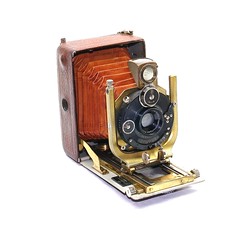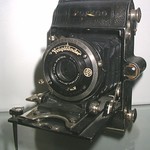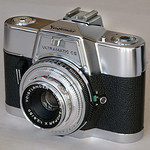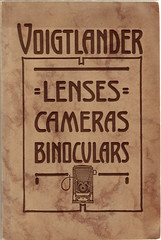Difference between revisions of "Voigtländer"
(Undo revision 108450 by RyanR.Warner (talk)) |
Hanskerensky (talk | contribs) m (→Links: Redirected Link URL to archived version) |
||
| (179 intermediate revisions by 24 users not shown) | |||
| Line 1: | Line 1: | ||
| − | {{Flickr image | + | {{RightTOC}} |
| − | | image_source=http://www.flickr.com/photos/89864432@N00/148809149/in/pool-camerawiki/ | + | '''Voigtländer''' (Germ. pronunciation ''"FOYKT-lender"'') was one of the the world's longest-lived camera and lens makers. The brand is still used by other firms. |
| − | | image=http://farm1.static.flickr.com/55/ | + | |
| − | | image_align= | + | |
| − | | image_text= | + | {| class="plainlinks" style="margin:10px 10px 10px 0px;" |
| + | | | ||
| + | {{Flickr_image | ||
| + | |image_source= https://www.flickr.com/photos/camerawiki/49125525823/in/pool-camerawiki | ||
| + | |image= https://live.staticflickr.com/65535/49125525823_0538fd5072_m.jpg | ||
| + | |image_align= left | ||
| + | |image_text= [[Bergheil]] Luxus 4×6.5 cm, c1911. | ||
| + | |image_by= eBayer Yalluflex | ||
| + | |image_rights= with permission | ||
| + | }} | ||
| + | |{{Flickr image | ||
| + | | image_source= http://www.flickr.com/photos/89864432@N00/148809149/in/pool-camerawiki/ | ||
| + | | image= http://farm1.static.flickr.com/55/148809149_28705ce36a_q.jpg | ||
| + | | image_align= left | ||
| + | | image_text= 1930s [[Perkeo]]<br/>with Skopar lens | ||
| + | | image_by= Uwe Kulick | ||
| + | | image_rights= with permission | ||
| + | }} | ||
| + | |{{Flickr_image | ||
| + | |image_source= http://www.flickr.com/photos/alf_sigaro/2337481015/in/pool-camerawiki | ||
| + | |image= http://farm4.static.flickr.com/3099/2337481015_c157be7250_q.jpg | ||
| + | |image_align= left | ||
| + | |image_text= 1950s [[Vitessa]] | ||
| + | |image_by= Alf Sigaro | ||
| + | |image_rights= nc | ||
| + | }} | ||
| + | {{Flickr_image | ||
| + | |image_source= http://www.flickr.com/photos/90900361@N08/11812588873/in/pool-camerawiki | ||
| + | |image= http://farm6.staticflickr.com/5515/11812588873_1c1041f493_q.jpg | ||
| + | |image_align= left | ||
| + | |image_text= 1965 [[Ultramatic CS]] | ||
| + | |image_by= Geoff Harrisson | ||
| + | |image_rights= wp | ||
}} | }} | ||
| − | + | |- | |
| + | |} | ||
| + | <br style="clear:left;" /> | ||
| + | ==Company history== | ||
| + | Voigtländer was founded in 1756 in Vienna, Austria by Johann Christoph Voigtländer, as a scientific instrument maker. Voigtländer was an optician and inventor, noted for his work on mathematical instruments, and held letters patent (a state-protected monopoly, the forerunner of a Patent) from the Austrian government, granting an exclusive right to carry on that business. For example, Voigtländer invented instruments for linear and circular measure (i.e. to measure and divide distances and angles with great precision) which were used for calibrating surveying and navigational instruments including astrolabes.<ref>For example, [http://www.christies.com Christie's] in London sold a [http://www.christies.com/lotfinder/lot_details.aspx?intObjectID=1796682 brass alidade by W. Voigtländer] of Vienna (one of J.C. Voigtländer's sons) in June 2000. An [http://en.wikipedia.org/wiki/Alidade alidade] is a surveying instrument for measuring or marking the horizontal angle of sighted landmarks.</ref> | ||
| + | <!-- Replaced this text: I will search for the patents or information on them, but I'm confident that what I've put is approximately what was meant. Not very relevant for a camera wiki; all we need to know is that V~ came from instrument making; Dustin McAmera, 30 Jan 2012. | ||
| + | In 1767 Voigtländer invented two very important tools, a 'classification engine for straight and tapered lines on a natural scale', and a 'circular classification engine to classify the degree rings, astrolabes and quadrants'.--> | ||
| + | |||
| + | Voigtländer died in 1797, and the company passed to his widow and two eldest sons, Wilhelm and Siegmund. Another son, Friedrich Voigtländer, took control in 1808. | ||
| + | {|class=floatleft | ||
| + | ||{{Flickr_image | ||
| + | |image_source= http://www.flickr.com/photos/sunivroc/7742124156/in/pool-camerawiki/ | ||
| + | |image= http://farm9.staticflickr.com/8303/7742124156_48ab898608_m.jpg | ||
| + | |image_text= catalog cover (1915) | ||
| + | |image_by= sunivroc | ||
| + | |image_rights= (C) | ||
| + | }} | ||
| + | |} | ||
| + | In the 19th century, Voigtländer made optical products including opera glasses and [[periscopic lens]]es. In 1840, the Hungarian [[Petzval|Josef Petzval]] designed the innovative [[Petzval lens]] for Voigtländer. The lens, with the widest relative aperture of any then made (about f/3), was very successful for its intended purpose: the making of [[daguerreotype]] portraits.<ref>Greenleaf, Allen R. ''Photographic Optics''. Macmillan, New York, 1950. p67-8.</ref> The wide aperture allowed a very considerable reduction in exposure times. The lens' main limitation (it only covers a narrow field of view) prevented it being adapted for other uses (landscape, for example), but does not matter for portraiture. The design was widely adopted, and Petzval lenses were made for about the next century. Voigtländer also made cameras, including the [[Daguerreotyp-Apparat zum Portraitiren | first all-metal daguerrotype camera]]. | ||
| + | |||
| + | In 1849 Voigtländer built a branch factory in Braunschweig (Brunswick) in Germany under the name Voigtländer & Sohn, Optical Institute, and in 1862 the company moved its headquarters to Braunschweig. In 1898 the company, until then family-owned, became a public company (i.e. sold shares on the stock market, becoming Voigtländer ''AG'').<ref>Thus [https://worldwide.espacenet.com/patent/search?q=pn%3DGB189718157A British Patent 18157 of 1897], ''Improvements in Photographic Objectives'', is in the name of Friedrich, Ritter von Voigtländer, while [https://worldwide.espacenet.com/patent/search?q=pn%3DUS716035A US Patent 716035 of 1902], ''Lens'', is in that of Voigtländer & Sohn Aktien Gesellschaft; both patents at [http://worldwide.espacenet.com/ Espacenet], the patent search facility of the European Patent Office.</ref> By 1915 the company had outgrown its buildings and moved to new premises in another part of Braunschweig. Unsurprisingly, the company made some military products during the First World War.<ref>For example, [http://www.pbase.com/g_hawkins/image/74774998 Voigtländer binoculars] at [http://www.pbase.com PBase].</ref> | ||
| + | |||
| + | Voigtländer remained independent after the War, when hard times (due in part to the effects of War reparations on Germany's economy) caused some other firms to enter mergers. In 1920, '''Rudolf Heidecke''' and '''Paul Franke''', employees of Voigtländer, left the firm to form [[Franke & Heidecke]] (their first camera, the [[Heidoscop]], bears a striking similarity to Voigtländer's [[Stereflektoskop]]; Heidecke was a designer, and it seems likely that he either had rights to this design, or had Voigtländer's blessing to use it). In 1925, Schering AG (a chemicals company) bought a majority share in Voigtländer. The company expanded its premises again in 1929. It was in the period of Schering's ownership that many of the familiar Voigtländer cameras were made, including the first [[Bessa]]. Voigtländer again made military equipment (including but not limited to aerial reconnaissance cameras, binoculars and rifle scopes) for Germany's rearmament and the Second World War, but continued development of cameras at least up to shortly before the War itself; the Bessa 466 was designed around 1938 (Voigtländer's British patent for this innovative camera was finalised in 1940, actually during the War)! During this time parts of production were moved to the Wolfenbüttel district (still on the outskirts of Braunschweig), where prisoners of war were employed. | ||
| + | |||
| + | In 1956 Schering sold its shares in Voigtländer to [[Carl Zeiss]]. | ||
| + | |||
| + | |||
| + | <!-- | ||
== Chronology == | == Chronology == | ||
| − | |||
| − | |||
| − | |||
| − | |||
| − | |||
| − | |||
* Founded by Johann Christoph Voigtländer in the year '''1756''' in Vienna (Austria), it was the first factory for optical instruments and precision mechanics there. | * Founded by Johann Christoph Voigtländer in the year '''1756''' in Vienna (Austria), it was the first factory for optical instruments and precision mechanics there. | ||
* In 1763 the company got protection by a decree from Austria's Empress Maria Theresia. | * In 1763 the company got protection by a decree from Austria's Empress Maria Theresia. | ||
| Line 24: | Line 77: | ||
* In 1898 Voigtländer became a stock market company. | * In 1898 Voigtländer became a stock market company. | ||
* In 1900 the "Reise Kamera" (travel camera) was introduced. | * In 1900 the "Reise Kamera" (travel camera) was introduced. | ||
| + | * In 1927 the company's first rollfilm cameras were introduced, in three different sizes. | ||
* In 1931 Voigtländer entered the mass market with the BESSA camera for 6x9 format. | * In 1931 Voigtländer entered the mass market with the BESSA camera for 6x9 format. | ||
* In '''1939''' the VITO, their first camera for [[35mm]] film, was well received by the customers. | * In '''1939''' the VITO, their first camera for [[35mm]] film, was well received by the customers. | ||
| Line 35: | Line 89: | ||
* In 1995 [[Ringfoto]] bought Plusfoto and the Voigtländer brand. | * In 1995 [[Ringfoto]] bought Plusfoto and the Voigtländer brand. | ||
* In 1999 the popular [[35mm]] viewfinder camera body '''[[Bessa_%2835mm%29#The_Bessa_L_and_T_.28finderless.29|Bessa L]]''' was introduced, developed and produced by [[Cosina]] | * In 1999 the popular [[35mm]] viewfinder camera body '''[[Bessa_%2835mm%29#The_Bessa_L_and_T_.28finderless.29|Bessa L]]''' was introduced, developed and produced by [[Cosina]] | ||
| + | --> | ||
| − | == | + | == Lenses == |
| + | <div class="floatleft plainlinks"> | ||
{{Flickr image | {{Flickr image | ||
| − | | image_source=http://www.flickr.com/photos/ | + | | image_source=http://www.flickr.com/photos/uwe_kulick/2720161631/in/pool-camerawiki |
| image=http://farm4.static.flickr.com/3175/2720161631_f8135677ed.jpg | | image=http://farm4.static.flickr.com/3175/2720161631_f8135677ed.jpg | ||
| − | | image_align= | + | | image_align= |
| − | | image_text=Lenses: Heliar, Dynar and Kollinear | + | | image_text=Lenses: [[Heliar]] (1902 variant), Dynar and [[Collinear|Kollinear]]<br/> |
| + | |image_rights=pd | ||
| + | }} | ||
| + | </div> | ||
| + | <div class="floatright plainlinks" style="margin:0px 0px 0px 30px;"> | ||
| + | {{Flickr image | ||
| + | | image_source=http://www.flickr.com/photos/89864432@N00/2720237637/in/pool-camerawiki/ | ||
| + | | image=http://farm3.static.flickr.com/2314/2720237637_95116e1221_m.jpg | ||
| + | | image_align= | ||
| + | | image_text=[[Petzval lens]] | ||
| + | |image_rights=pd | ||
}} | }} | ||
| − | Despite | + | </div> |
| + | {|class="floatright plainlinks" | ||
| + | |[http://www.flickr.com/photos/siimvahur/3586609760/in/pool-camerawiki http://farm3.static.flickr.com/2456/3586609760_e4c2de4d13_m.jpg] | ||
| + | |- | ||
| + | |[http://www.flickr.com/photos/siimvahur/3586594396/in/pool-camerawiki http://farm4.static.flickr.com/3644/3586594396_1a819f559b_m.jpg] | ||
| + | |- | ||
| + | |No. 9643 <br/><small>images by {{image author|Siim Vahur}} {{with permission}} | ||
| + | |- | ||
| + | |[http://www.flickr.com/photos/heritagefutures/8093076536/in/pool-camerawiki http://farm9.staticflickr.com/8196/8093076536_5825c8e4e1_m.jpg] | ||
| + | |- | ||
| + | |Tele-Dynar <br/><small>images by {{image author|Dirk HR Spennemann}} {{with permission}}</small> | ||
| + | |} | ||
| + | Despite the successful early metal camera designed by Voigtländer, ''lenses'' were the company's main contribution to photography in the 19th century, and the success of Voigtländer's camera lines of the 20th century was based on the quality of its lenses. At the turn of the 20th century, Voigtländer had a branch office in New York, ''Voigtlander & Son Optical Co.'' (with no umlaut), advertising Voigtländer lenses like the Dynar for use with the better [[Kodak]] cameras. | ||
| − | + | While still in Austria, Voigtländer introduced the [[Petzval lens]], which became a standard lens for portrait photography: Voigtländer's Petzval lenses were fitted to cameras of many makers. The lens has four elements, divided in two groups, the two front elements cemented, the two back elements just placed close to each other. The lens has a characteristic vignetting and curvature of field, but it made images which were very sharp in the centre. This and its wide aperture make it ideal for portraiture, though of little use for other photography; portrait photography was a big business, however. | |
| + | In 1900 Carl August Hans Harting, working for Voigtländer produced another fast lens, the '''Heliar''', a symmetric lens, improved by him as an asymmetric design in 1902. Other fine lens designs of that time were the '''Dynar''' and '''Kollinear''' (later Collinear) lenses. During the 20th century the '''Skopar''' and '''Color Skopar''', and '''Ultron''' lenses became the standard lenses for Voigtländer's own cameras. Voigtländer also made the '''Zoomar''', the world's first interchangeable zoom lens, in 1959.<ref>[https://worldwide.espacenet.com/patent/search?q=pn%3DUS2902901A US Patent 2902901], ''Reflex camera varifocal lens'', filed June 1958 and granted September 1959 to Frank Back personally, and [https://worldwide.espacenet.com/patent/search?q=pn%3DDE1094480B German Patent 1094480], ''Pankratisches Objektiv für Aufnahme- und Wiedergabe-Zwecke'' (A Pancratic Objective for Taking and Projection), filed January 1959 and granted December 1960 to Voigtländer AG, citing Frank Back as the inventor; at Espacenet.</ref> | ||
| − | + | The Voigtländer camera and lens age can be determined by the serial number on the lens. See this [http://www.klassik-cameras.de/voigtlaender_SN.jpg Voigtländer lens serial-number reference] to date the original production year. | |
| − | + | {{Flickr_image | |
| − | + | |image_source= https://www.flickr.com/photos/90900361@N08/51246057108/in/pool-camerawiki | |
| − | + | |image= https://live.staticflickr.com/65535/51246057108_751ce375c3_m.jpg | |
| + | |image_align= | ||
| + | |image_text= Voigtländer Zoomar lens | ||
| + | |image_by= Geoff Harrisson | ||
| + | |image_rights= wp | ||
| + | }} | ||
| − | |||
| − | |||
| − | |||
| − | |||
| − | |||
| − | |||
| − | |||
<br style="clear:left" /> | <br style="clear:left" /> | ||
'''Lenses''' | '''Lenses''' | ||
| + | * [[Apo-Lanthar]] | ||
| + | * [[Collinear]] / Kollinear f/6.3 | ||
| + | * Color Skopar | ||
| + | * Dynar | ||
| + | * Dynaron | ||
| + | * [[Heliar]] | ||
| + | * Lanthar | ||
* Petzval portrait lens | * Petzval portrait lens | ||
| − | |||
| − | |||
* Radiar | * Radiar | ||
| − | |||
* Skopar | * Skopar | ||
| − | * | + | * Skoparon |
| + | * Tele-Dynar f/6.3 | ||
| + | * [[Ultron]] | ||
| + | * [[Voigtländer Weichzeichner]] | ||
| + | * Vaskar | ||
| + | * Voigtar | ||
* Zoomar | * Zoomar | ||
| − | + | ||
| − | |||
| − | |||
See [[Serial_numbers | here]] for dating the serial numbers of Voigtländer lenses. | See [[Serial_numbers | here]] for dating the serial numbers of Voigtländer lenses. | ||
{{br}} | {{br}} | ||
| − | == | + | == Shutters == |
| − | === | + | *Verschluss (1890), one of the first modern [[leaf shutter]]s, with 4 blades |
| + | |||
| + | <br/> | ||
| + | |||
| + | == Cameras == | ||
| + | === Early cameras === | ||
* 1840: [[Daguerreotyp-Apparat zum Portraitiren]] | * 1840: [[Daguerreotyp-Apparat zum Portraitiren]] | ||
* 1890: Reisekamera | * 1890: Reisekamera | ||
| Line 85: | Line 174: | ||
=== 35mm SLR === | === 35mm SLR === | ||
| − | + | {{Flickr_image | |
| + | |image_source= http://www.flickr.com/photos/ricksoloway/2810210248/in/pool-camerawiki | ||
| + | |image= http://farm4.static.flickr.com/3202/2438753583_0ff48309e4_t.jpg | ||
| + | |image_align= right | ||
| + | |image_text= Bessamatic | ||
| + | |image_by= Rick Soloway | ||
| + | |image_rights= with permission | ||
| + | }} | ||
* [[Bessamatic]] | * [[Bessamatic]] | ||
* [[Bessamatic|Bessamatic de Luxe]] | * [[Bessamatic|Bessamatic de Luxe]] | ||
| Line 93: | Line 189: | ||
* [[Ultramatic CS]] | * [[Ultramatic CS]] | ||
| − | === 35mm | + | ===35mm RF, interchangeable lens=== |
* [[Prominent (35mm)|Prominent]] | * [[Prominent (35mm)|Prominent]] | ||
* [[Prominent (35mm)|Prominent II]] | * [[Prominent (35mm)|Prominent II]] | ||
| − | * [[Vitessa T]] | + | * [[Vitessa#Vitessa T|Vitessa T]] |
=== 35mm folding === | === 35mm folding === | ||
| Line 106: | Line 202: | ||
=== 35mm fixed lens === | === 35mm fixed lens === | ||
| − | + | {{Flickr_image | |
| + | |image_source= http://www.flickr.com/photos/jokerphotography/6348352941/in/pool-camerawiki | ||
| + | |image= http://farm7.staticflickr.com/6216/6348352941_1fb268a371_t.jpg | ||
| + | |image_align= right | ||
| + | |image_text= Vito automatic | ||
| + | |image_by= inetjoker | ||
| + | |image_rights= with permission | ||
| + | }} | ||
* [[Vito B]], small or big finder | * [[Vito B]], small or big finder | ||
| − | * [[Vito | + | * [[Voigtlander Vito BL|Vito BL]] |
* [[Vito B|Vito BR]] | * [[Vito B|Vito BR]] | ||
| − | * [[ | + | * [[Vitomatic I]] |
* [[Vitomatic|Vitomatic II]] | * [[Vitomatic|Vitomatic II]] | ||
* [[Vitomatic|Vitomatic Ia]] | * [[Vitomatic|Vitomatic Ia]] | ||
| Line 125: | Line 228: | ||
* [[Vito C|Vito CLR]] | * [[Vito C|Vito CLR]] | ||
* [[Vito C|Vito CS]] | * [[Vito C|Vito CS]] | ||
| − | * [[ | + | * [[Vito CSR]] |
* [[Vito Automatic]] | * [[Vito Automatic]] | ||
* [[Vito Automatic I]] | * [[Vito Automatic I]] | ||
| Line 132: | Line 235: | ||
* [[Dynamatic]] | * [[Dynamatic]] | ||
* [[Dynamatic II]] | * [[Dynamatic II]] | ||
| − | * Vitoret | + | * [[Vitoret]] |
| − | * Vitoret F | + | * [[Vitoret F]] |
| − | * Vitoret R | + | * [[Vitoret R]] |
| − | * Vitoret L / LR | + | * [[Vitoret L / LR]] |
* [[Vitoret D / DR]] | * [[Vitoret D / DR]] | ||
| − | * Vitoret Rapid D | + | * [[Vitoret Rapid D]] |
* [[Voigtländer Vitrona|Vitrona]] | * [[Voigtländer Vitrona|Vitrona]] | ||
| + | |||
| + | === 116 folding === | ||
| + | * [[Rollfilmkamera]] (or [[Rollfilmkamera|Rollfilm]]) (6.5×11) | ||
| + | |||
| + | === 120 box === | ||
| + | {{Flickr_image | ||
| + | |image_source= https://www.flickr.com/photos/16837055@N00/50303439252/in/pool-camerawiki/ | ||
| + | |image= https://live.staticflickr.com/65535/50303439252_e20e412678_t.jpg | ||
| + | |image_align= right | ||
| + | |image_text= Voigtländer Box | ||
| + | |image_by= Carrot Room | ||
| + | |image_rights= with permission | ||
| + | }} | ||
| + | * [[Bilora Box|Voigtländer Box]] | ||
| + | {{br}} | ||
=== 120 folding === | === 120 folding === | ||
| − | + | {{Flickr_image | |
| + | |image_source= http://www.flickr.com/photos/n6nkn/155608914/ | ||
| + | |image= http://farm1.static.flickr.com/66/155608914_2c59b041cc_t.jpg | ||
| + | |image_align= right | ||
| + | |image_text= Bessa | ||
| + | |image_by= Rick Zolla | ||
| + | |image_rights= wp | ||
| + | }} | ||
* [[Inos|Inos I]] (6×9) | * [[Inos|Inos I]] (6×9) | ||
| − | * [[Inos|Inos II]] (6×9) | + | * [[Inos|Inos II]] (6×9) (6.5x11) |
| − | * Virtus (4.5×6) | + | * [[Jubilar]] (6x9) |
| + | * [[Virtus]] (4.5×6) | ||
* [[Prominent (6×9)|Prominent]] (6×9) | * [[Prominent (6×9)|Prominent]] (6×9) | ||
* [[Bessa (folders)|Bessa (prewar)]] (6×9) | * [[Bessa (folders)|Bessa (prewar)]] (6×9) | ||
| Line 150: | Line 276: | ||
* [[Bessa (folders)|Bessa I]] (6×9) | * [[Bessa (folders)|Bessa I]] (6×9) | ||
* [[Bessa (folders)|Bessa II]] (6×9) | * [[Bessa (folders)|Bessa II]] (6×9) | ||
| − | * [[Bessa 46]] (4.5×6) | + | * Klein Bessa or [[Baby Bessa]] |
| − | * [[Bessa 66]] (6×6) | + | ** [[Bessa 46]] (4.5×6) |
| − | * Perkeo | + | ** [[Bessa 66]] (6×6) |
| + | ** Bessa 466 | ||
| + | * [[Perkeo]] (6×6) | ||
* [[Perkeo II]] (6×6) | * [[Perkeo II]] (6×6) | ||
| − | * Perkeo E (6×6) | + | * [[Perkeo_II|Perkeo E]] (6×6) |
| − | * Rollfilmkamera (6×9) | + | * [[Rollfilmkamera]] (or [[Rollfilmkamera|Rollfilm]]) (6×9) |
| + | |||
| + | {{Flickr_image | ||
| + | |image_source= http://www.flickr.com/photos/90900361@N08/8266860818/in/pool-camerawiki/ | ||
| + | |image= http://farm9.staticflickr.com/8350/8266860818_fc4617a8c3_t.jpg | ||
| + | |image_align= right | ||
| + | |image_text= Superb | ||
| + | |image_by= Geoff Harrisson | ||
| + | |image_rights= wp | ||
| + | }} | ||
=== 120 TLR === | === 120 TLR === | ||
| Line 162: | Line 299: | ||
=== 127 folding === | === 127 folding === | ||
| − | * Perkeo (3×4) | + | * [[Perkeo]] (3×4) |
| + | |||
| + | === 129 folding === | ||
| + | * [[Rollfilmkamera]] (or [[Rollfilmkamera|Rollfilm]]) (5×8) | ||
=== Folding plate cameras === | === Folding plate cameras === | ||
| − | + | {{Flickr_image | |
| − | * [[Alpin]] | + | |image_source= http://www.flickr.com/photos/captkodak/272750795/in/pool-camerawiki/ |
| − | * Alpin Rapid | + | |image= http://farm1.static.flickr.com/100/272750795_4cfb01879b_t.jpg |
| + | |image_align= right | ||
| + | |image_text= VAG | ||
| + | |image_by= Steve Harwood | ||
| + | |image_rights= nc | ||
| + | }} | ||
| + | * [[Alpin]] (9x12 and 10x15) (1906-1928) | ||
| + | * Alpin Rapid (9x12) (1925) | ||
* [[Avus]] | * [[Avus]] | ||
* [[Bergheil]] | * [[Bergheil]] | ||
| + | * Metall-Heliar-Kamera (9x12) (1903-1920) | ||
* VAG | * VAG | ||
| − | === | + | === Reflex cameras === |
| + | * 1905 onward: [[Spiegel-Reflex-Kamera (Voigtländer)|Spiegel-Reflex-Kamera]] (various models and sizes, 1905-1925). Some of these were also named the Heliar Reflex | ||
| + | * 1908: [[Voigtländer Bijou|Bijou]] ('Miniatur-Reflex-Kamera'; 4.5x6 cm) | ||
| − | + | {{Flickr_image | |
| − | + | |image_source= http://www.flickr.com/photos/90900361@N08/8273206575/in/pool-camerawiki/ | |
| − | + | |image= http://farm9.staticflickr.com/8364/8273206575_4f1ff9b33e_s.jpg | |
| − | + | |image_align= right | |
| − | === | + | |image_text= Stereflektoskop 45x107 |
| + | |image_by= Geoff Harrisson | ||
| + | |image_rights= wp | ||
| + | }} | ||
| + | === Stereo cameras === | ||
* 1902: Stereoskop | * 1902: Stereoskop | ||
| − | * 1905: Stereo and Panorama Kamera ( | + | * 1904: [[Stereophotoskop]] (4.5×10.7 cm plates) |
| − | + | * 1905: Stereo and Panorama Kamera (9×14) | |
| − | * 1911: Alpin Stereo ( | + | * 1911: [[Alpin|Alpin Stereo]] (10×15) |
* 1912: Spiegelreflex-Stereo | * 1912: Spiegelreflex-Stereo | ||
| − | * | + | * 1914: [[Stereflektoskop]] (4.5×10.7 and 6×13 cm) |
| + | |||
| + | ===Other plate cameras=== | ||
| + | * 1903: [[Voigtländer Scheren-Camera|Scheren-Camera]]; 9x12 cm scissor-strut hand-and-stand camera | ||
== Zeiss Ikon / Voigtländer == | == Zeiss Ikon / Voigtländer == | ||
=== 35mm SLR === | === 35mm SLR === | ||
For the [[Icarex]] line, see [[Zeiss Ikon]]. | For the [[Icarex]] line, see [[Zeiss Ikon]]. | ||
| + | {{Flickr_image | ||
| + | |image_source= http://www.flickr.com/photos/kratz/2100973142/in/pool-camerawiki/ | ||
| + | |image= http://farm3.static.flickr.com/2295/2100973142_b183a7ba9b_t.jpg | ||
| + | |image_align=right | ||
| + | |image_text= | ||
| + | |image_by= John Kratz | ||
| + | |image_rights= wp | ||
| + | }} | ||
=== 35mm fixed lens === | === 35mm fixed lens === | ||
| − | + | * Vitessa 500 L / 500 S / [[Vitessa_500_AE|500 AE electronic]] / 500 SE electronic / 1000 SR | |
| − | * Vitessa 500 L / 500 S / 500 AE electronic / 500 SE electronic / 1000 SR | + | |
=== [[126 film]] viewfinder === | === [[126 film]] viewfinder === | ||
* Bessy k/ak/as/s | * Bessy k/ak/as/s | ||
| Line 202: | Line 367: | ||
* [[Voigtländer VSL|VSL 1 (TM)]] | * [[Voigtländer VSL|VSL 1 (TM)]] | ||
* [[Voigtländer VSL|VSL 2CX automatic]] (prototypes) | * [[Voigtländer VSL|VSL 2CX automatic]] (prototypes) | ||
| + | {{Flickr_image | ||
| + | |image_source= http://www.flickr.com/photos/draculro/7604177086/in/pool-camerawiki | ||
| + | |image= http://farm9.staticflickr.com/8161/7604177086_4ccaa92566_t.jpg | ||
| + | |image_align= right | ||
| + | |image_text= | ||
| + | |image_by= Nicodemus Roger | ||
| + | |image_rights= wp | ||
| + | }} | ||
With [[Rolleiflex SL35 lenses]]: | With [[Rolleiflex SL35 lenses]]: | ||
* [[Voigtländer VSL|VSL 1 (BM)]] | * [[Voigtländer VSL|VSL 1 (BM)]] | ||
| Line 211: | Line 384: | ||
* [[Voigtländer VF 101|VF 101]] (1974–76) | * [[Voigtländer VF 101|VF 101]] (1974–76) | ||
* VF 102 (1974, prototype) | * VF 102 (1974, prototype) | ||
| − | * VF 135 (1976–80) | + | * [[Voigtländer VF 135|VF 135]] (1976–80) |
| − | * VF 35F (1981) | + | * [[Voigtländer VF 35F|VF 35F]] (1981) |
* XF 35 (1981) | * XF 35 (1981) | ||
| Line 219: | Line 392: | ||
* Vito | * Vito | ||
* [[Voigtländer Vito C|Vito C]] | * [[Voigtländer Vito C|Vito C]] | ||
| + | {{Flickr_image | ||
| + | |image_source= http://www.flickr.com/photos/tony_kemplen/6443134393/in/pool-camerawiki | ||
| + | |image= http://farm8.staticflickr.com/7023/6443134393_44afb7511f_t.jpg | ||
| + | |image_align= right | ||
| + | |image_text= | ||
| + | |image_by= Tony Kemplen | ||
| + | |image_rights= wp | ||
| + | }} | ||
* Vito CS | * Vito CS | ||
* Vito C-AF | * Vito C-AF | ||
| Line 226: | Line 407: | ||
* [[Voigtländer Vitoret 110 EL|Vitoret 110 EL]] (1976–81) | * [[Voigtländer Vitoret 110 EL|Vitoret 110 EL]] (1976–81) | ||
| − | == | + | == Cosina and Ringfoto == |
Long after the demise of the original Voigtländer company, the brand was re-used by [[Ringfoto]] and [[Cosina]]. | Long after the demise of the original Voigtländer company, the brand was re-used by [[Ringfoto]] and [[Cosina]]. | ||
| − | * [[Voigtländer- | + | |
| − | * [[ | + | * [[Cosina Voigtländer]] (new series [[rangefinder camera]]s and lenses) |
| + | * [[Cosina_Voigtländer#35mm_SLR | Voigtländer-branded SLRs from Cosina]] (includes those distributed by Ringfoto) | ||
| + | * [[:Category:Voigtländer-brand Ringfoto products| Wiki articles on Voigtländer-brand Ringfoto products]] | ||
| + | |||
| + | ==Notes== | ||
| + | <references /> | ||
== Links == | == Links == | ||
| − | + | ||
| − | * [http://www.voigtlaender.de Voigtländer | + | * [http://www.voigtlaender.de Voigtländer.de] Manufacturer's site (German & English) |
| − | |||
| − | |||
| − | |||
| − | |||
* [http://www.bubley.com/verein/index.html Voigtländer Verein Club] | * [http://www.bubley.com/verein/index.html Voigtländer Verein Club] | ||
| − | * [http://www. | + | * [http://www.photo-manuals.com/manual/voigtlander Voigtländer Camera Manuals : Photo-Manuals.com] |
| − | * [http://www.ukcamera.com/classic_cameras/Kamerahersteller/voigtlaender.htm Voigtländers on ukcameras] | + | * [https://web.archive.org/web/20180705011600/http://www.ukcamera.com/classic_cameras/Kamerahersteller/voigtlaender.htm Voigtländers on ukcameras] (archived) |
| − | |||
* [http://collectiblend.com/Cameras/Voigtlander/ Voigtländer Cameras Price Guide] at [http://collectiblend.com CollectiBlend] | * [http://collectiblend.com/Cameras/Voigtlander/ Voigtländer Cameras Price Guide] at [http://collectiblend.com CollectiBlend] | ||
| − | * [http://www.butkus.org/chinon/voigtlander.htm Voigtlander instruction manuals - English] at Orphancameras.com | + | * [http://www.butkus.org/chinon/voigtlander.htm Extensive list of Voigtlander instruction manuals, PDF format, color - most in English] at Orphancameras.com |
| − | * [http://www.photo- | + | * [http://www.jollinger.com/photo/cam-coll/histories/history-voigtlander.html Ollinger's History of Voigtländer] |
| + | * [https://web.archive.org/web/20180706154221/http://voigtlander.pagesperso-orange.fr/index.htm Voigtländer Camera Collection] (archived) Good Overview, English & French | ||
| + | * [https://www.butkus.org/chinon/voigtlander.htm Voigtlander PDF manuals, mostly English, some German] at [https://www.butkus.org/chinon/ Butkus.org] | ||
In French : | In French : | ||
| − | * [ | + | * [https://www.collectiongeven.com/piwigo/index.php?/category/134 Voigtländer page] at [https://www.collectiongeven.com/piwigo/ Collection G. Even's site]. |
| − | * [http:// | + | In German : |
| + | * [http://www.klassik-cameras.de/Bessa_RF_histo_dt.html lenses of Voigtländer] on [http://www.klassik-cameras.de taunusreiter.de] | ||
| + | * [http://www.klassik-cameras.de/Voigtlaender_Main.html Voigtländer page by Frank Mechelhoff] | ||
| + | * [http://www.schoebels-voigtlaender-archiv.de/ Schoebels' Voigtländer archive] | ||
| + | * [https://web.archive.org/web/20210301161930/http://hans.lissberger.at/ Meine Voigtländer-Sammlung] (archived) by Hans Lißberger | ||
| + | * [http://de.wikipedia.org/wiki/Voigtl%C3%A4nder_(Marke) Voigtländer on the German Wikipedia.] | ||
| + | ** [http://de.wikipedia.org/wiki/Johann_Christoph_Voigtl%C3%A4nder Johann Christopher Voigtländer] | ||
| + | ** [http://de.wikipedia.org/wiki/Johann_Friedrich_Voigtl%C3%A4nder Johann Friedrich Voigtländer] | ||
| + | ** [http://de.wikipedia.org/wiki/Peter_Wilhelm_Friedrich_von_Voigtl%C3%A4nder Peter Wilhelm Fredrich von Voigtländer] | ||
| + | * [http://www.klassik-cameras.de/index.html Cameras of the 1950's] | ||
[[Category: German camera makers]] | [[Category: German camera makers]] | ||
[[Category: German lens makers]] | [[Category: German lens makers]] | ||
| + | [[Category: Lens makers]] | ||
[[Category: Voigtländer|*]] | [[Category: Voigtländer|*]] | ||
[[Category: Austria]] | [[Category: Austria]] | ||
Latest revision as of 05:20, 22 December 2023
Voigtländer (Germ. pronunciation "FOYKT-lender") was one of the the world's longest-lived camera and lens makers. The brand is still used by other firms.
|
|
|
Company history
Voigtländer was founded in 1756 in Vienna, Austria by Johann Christoph Voigtländer, as a scientific instrument maker. Voigtländer was an optician and inventor, noted for his work on mathematical instruments, and held letters patent (a state-protected monopoly, the forerunner of a Patent) from the Austrian government, granting an exclusive right to carry on that business. For example, Voigtländer invented instruments for linear and circular measure (i.e. to measure and divide distances and angles with great precision) which were used for calibrating surveying and navigational instruments including astrolabes.[1]
Voigtländer died in 1797, and the company passed to his widow and two eldest sons, Wilhelm and Siegmund. Another son, Friedrich Voigtländer, took control in 1808.
|
In the 19th century, Voigtländer made optical products including opera glasses and periscopic lenses. In 1840, the Hungarian Josef Petzval designed the innovative Petzval lens for Voigtländer. The lens, with the widest relative aperture of any then made (about f/3), was very successful for its intended purpose: the making of daguerreotype portraits.[2] The wide aperture allowed a very considerable reduction in exposure times. The lens' main limitation (it only covers a narrow field of view) prevented it being adapted for other uses (landscape, for example), but does not matter for portraiture. The design was widely adopted, and Petzval lenses were made for about the next century. Voigtländer also made cameras, including the first all-metal daguerrotype camera.
In 1849 Voigtländer built a branch factory in Braunschweig (Brunswick) in Germany under the name Voigtländer & Sohn, Optical Institute, and in 1862 the company moved its headquarters to Braunschweig. In 1898 the company, until then family-owned, became a public company (i.e. sold shares on the stock market, becoming Voigtländer AG).[3] By 1915 the company had outgrown its buildings and moved to new premises in another part of Braunschweig. Unsurprisingly, the company made some military products during the First World War.[4]
Voigtländer remained independent after the War, when hard times (due in part to the effects of War reparations on Germany's economy) caused some other firms to enter mergers. In 1920, Rudolf Heidecke and Paul Franke, employees of Voigtländer, left the firm to form Franke & Heidecke (their first camera, the Heidoscop, bears a striking similarity to Voigtländer's Stereflektoskop; Heidecke was a designer, and it seems likely that he either had rights to this design, or had Voigtländer's blessing to use it). In 1925, Schering AG (a chemicals company) bought a majority share in Voigtländer. The company expanded its premises again in 1929. It was in the period of Schering's ownership that many of the familiar Voigtländer cameras were made, including the first Bessa. Voigtländer again made military equipment (including but not limited to aerial reconnaissance cameras, binoculars and rifle scopes) for Germany's rearmament and the Second World War, but continued development of cameras at least up to shortly before the War itself; the Bessa 466 was designed around 1938 (Voigtländer's British patent for this innovative camera was finalised in 1940, actually during the War)! During this time parts of production were moved to the Wolfenbüttel district (still on the outskirts of Braunschweig), where prisoners of war were employed.
In 1956 Schering sold its shares in Voigtländer to Carl Zeiss.
Lenses
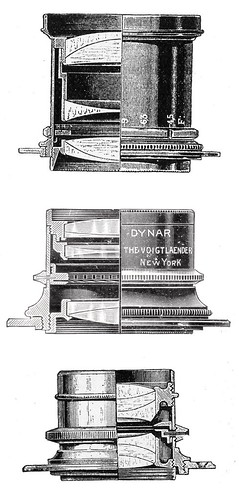
|
| Lenses: Heliar (1902 variant), Dynar and Kollinear (Image rights) |

|
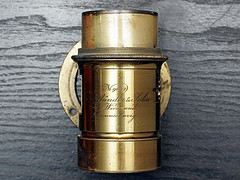
|
| No. 9643 images by Siim Vahur (Image rights) |
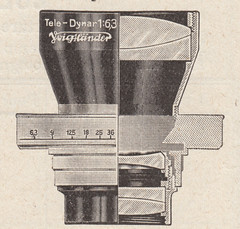
|
| Tele-Dynar images by Dirk HR Spennemann (Image rights) |
Despite the successful early metal camera designed by Voigtländer, lenses were the company's main contribution to photography in the 19th century, and the success of Voigtländer's camera lines of the 20th century was based on the quality of its lenses. At the turn of the 20th century, Voigtländer had a branch office in New York, Voigtlander & Son Optical Co. (with no umlaut), advertising Voigtländer lenses like the Dynar for use with the better Kodak cameras.
While still in Austria, Voigtländer introduced the Petzval lens, which became a standard lens for portrait photography: Voigtländer's Petzval lenses were fitted to cameras of many makers. The lens has four elements, divided in two groups, the two front elements cemented, the two back elements just placed close to each other. The lens has a characteristic vignetting and curvature of field, but it made images which were very sharp in the centre. This and its wide aperture make it ideal for portraiture, though of little use for other photography; portrait photography was a big business, however. In 1900 Carl August Hans Harting, working for Voigtländer produced another fast lens, the Heliar, a symmetric lens, improved by him as an asymmetric design in 1902. Other fine lens designs of that time were the Dynar and Kollinear (later Collinear) lenses. During the 20th century the Skopar and Color Skopar, and Ultron lenses became the standard lenses for Voigtländer's own cameras. Voigtländer also made the Zoomar, the world's first interchangeable zoom lens, in 1959.[5]
The Voigtländer camera and lens age can be determined by the serial number on the lens. See this Voigtländer lens serial-number reference to date the original production year.

|
| Voigtländer Zoomar lens image by Geoff Harrisson (Image rights) |
Lenses
- Apo-Lanthar
- Collinear / Kollinear f/6.3
- Color Skopar
- Dynar
- Dynaron
- Heliar
- Lanthar
- Petzval portrait lens
- Radiar
- Skopar
- Skoparon
- Tele-Dynar f/6.3
- Ultron
- Voigtländer Weichzeichner
- Vaskar
- Voigtar
- Zoomar
See here for dating the serial numbers of Voigtländer lenses.
Shutters
- Verschluss (1890), one of the first modern leaf shutters, with 4 blades
Cameras
Early cameras
- 1840: Daguerreotyp-Apparat zum Portraitiren
- 1890: Reisekamera
- 1900: Reisekamera Typ A
- Reisekamera Tropical
35mm SLR

|
| Bessamatic image by Rick Soloway (Image rights) |
35mm RF, interchangeable lens
35mm folding
35mm fixed lens

|
| Vito automatic image by inetjoker (Image rights) |
- Vito B, small or big finder
- Vito BL
- Vito BR
- Vitomatic I
- Vitomatic II
- Vitomatic Ia
- Vitomatic IIa
- Vitomatic Ib
- Vitomatic IIb
- Vitomatic IIIb
- Vitomatic ICS
- Vitomatic IICS
- Vitomatic IIICS
- Vito C
- Vito CD
- Vito CL
- Vito CLR
- Vito CS
- Vito CSR
- Vito Automatic
- Vito Automatic I
- Vito Automatic II
- Vito Automatic F and R
- Dynamatic
- Dynamatic II
- Vitoret
- Vitoret F
- Vitoret R
- Vitoret L / LR
- Vitoret D / DR
- Vitoret Rapid D
- Vitrona
116 folding
- Rollfilmkamera (or Rollfilm) (6.5×11)
120 box

|
| Voigtländer Box image by Carrot Room (Image rights) |
120 folding

|
| Bessa image by Rick Zolla (Image rights) |
- Inos I (6×9)
- Inos II (6×9) (6.5x11)
- Jubilar (6x9)
- Virtus (4.5×6)
- Prominent (6×9)
- Bessa (prewar) (6×9)
- Bessa RF (6×9)
- Bessa I (6×9)
- Bessa II (6×9)
- Klein Bessa or Baby Bessa
- Perkeo (6×6)
- Perkeo II (6×6)
- Perkeo E (6×6)
- Rollfilmkamera (or Rollfilm) (6×9)

|
| Superb image by Geoff Harrisson (Image rights) |
120 TLR
127 folding
- Perkeo (3×4)
129 folding
- Rollfilmkamera (or Rollfilm) (5×8)
Folding plate cameras

|
| VAG image by Steve Harwood (Image rights) |
- Alpin (9x12 and 10x15) (1906-1928)
- Alpin Rapid (9x12) (1925)
- Avus
- Bergheil
- Metall-Heliar-Kamera (9x12) (1903-1920)
- VAG
Reflex cameras
- 1905 onward: Spiegel-Reflex-Kamera (various models and sizes, 1905-1925). Some of these were also named the Heliar Reflex
- 1908: Bijou ('Miniatur-Reflex-Kamera'; 4.5x6 cm)

|
| Stereflektoskop 45x107 image by Geoff Harrisson (Image rights) |
Stereo cameras
- 1902: Stereoskop
- 1904: Stereophotoskop (4.5×10.7 cm plates)
- 1905: Stereo and Panorama Kamera (9×14)
- 1911: Alpin Stereo (10×15)
- 1912: Spiegelreflex-Stereo
- 1914: Stereflektoskop (4.5×10.7 and 6×13 cm)
Other plate cameras
- 1903: Scheren-Camera; 9x12 cm scissor-strut hand-and-stand camera
Zeiss Ikon / Voigtländer
35mm SLR
For the Icarex line, see Zeiss Ikon.

|
| image by John Kratz (Image rights) |
35mm fixed lens
- Vitessa 500 L / 500 S / 500 AE electronic / 500 SE electronic / 1000 SR
126 film viewfinder
- Bessy k/ak/as/s
- Vitessa 126 CS / 126 electronic / 126 S electronic
Voigtländer (Rollei)
35mm SLR
With 42mm screw lenses:
- VSL 1 (TM)
- VSL 2CX automatic (prototypes)

|
| image by Nicodemus Roger (Image rights) |
With Rolleiflex SL35 lenses:
- VSL 1 (BM)
- VSL 2 automatic
- VSL 3-E
- Vitoflex E (prototypes)
35mm rangefinder
Intermediate period
35mm
- Vito
- Vito C

|
| image by Tony Kemplen (Image rights) |
- Vito CS
- Vito C-AF
110 film pocket camera
- Vitoret 110 (1976–81)
- Vitoret 110 EL (1976–81)
Cosina and Ringfoto
Long after the demise of the original Voigtländer company, the brand was re-used by Ringfoto and Cosina.
- Cosina Voigtländer (new series rangefinder cameras and lenses)
- Voigtländer-branded SLRs from Cosina (includes those distributed by Ringfoto)
- Wiki articles on Voigtländer-brand Ringfoto products
Notes
- ↑ For example, Christie's in London sold a brass alidade by W. Voigtländer of Vienna (one of J.C. Voigtländer's sons) in June 2000. An alidade is a surveying instrument for measuring or marking the horizontal angle of sighted landmarks.
- ↑ Greenleaf, Allen R. Photographic Optics. Macmillan, New York, 1950. p67-8.
- ↑ Thus British Patent 18157 of 1897, Improvements in Photographic Objectives, is in the name of Friedrich, Ritter von Voigtländer, while US Patent 716035 of 1902, Lens, is in that of Voigtländer & Sohn Aktien Gesellschaft; both patents at Espacenet, the patent search facility of the European Patent Office.
- ↑ For example, Voigtländer binoculars at PBase.
- ↑ US Patent 2902901, Reflex camera varifocal lens, filed June 1958 and granted September 1959 to Frank Back personally, and German Patent 1094480, Pankratisches Objektiv für Aufnahme- und Wiedergabe-Zwecke (A Pancratic Objective for Taking and Projection), filed January 1959 and granted December 1960 to Voigtländer AG, citing Frank Back as the inventor; at Espacenet.
Links
- Voigtländer.de Manufacturer's site (German & English)
- Voigtländer Verein Club
- Voigtländer Camera Manuals : Photo-Manuals.com
- Voigtländers on ukcameras (archived)
- Voigtländer Cameras Price Guide at CollectiBlend
- Extensive list of Voigtlander instruction manuals, PDF format, color - most in English at Orphancameras.com
- Ollinger's History of Voigtländer
- Voigtländer Camera Collection (archived) Good Overview, English & French
- Voigtlander PDF manuals, mostly English, some German at Butkus.org
In French :
In German :
